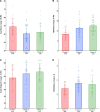Profiles of Risk and Resilience in Chronic Pain: Loneliness, Social Support, Mindfulness, and Optimism Coming out of the First Pandemic Year
- PMID: 35587150
- PMCID: PMC9384018
- DOI: 10.1093/pm/pnac079
Profiles of Risk and Resilience in Chronic Pain: Loneliness, Social Support, Mindfulness, and Optimism Coming out of the First Pandemic Year
Abstract
Objective: Individuals experience chronic pain differently, not only because of different clinical diagnoses, but also because of differing degrees of influence from biopsychosocial pain modulators. We aimed to cluster patients with chronic pain into distinct subgroups based on psychosocial characteristics and pain intensity, and we subsequently examined group differences in pain-related interference approximately 1 year later.
Methods: In this observational, longitudinal study, patients with chronic pain (n = 94) completed validated assessments of psychosocial characteristics and pain intensity at the beginning of COVID-19-related social distancing (April to June 2020). One year later (May to June 2021), patients completed a follow-up survey with assessments of pain interference, loneliness, social support, mindfulness, and optimism.
Results: A cluster analysis, using psychosocial factors and pain intensity, empirically produced three patient groups: 1) psychosocial predominant (PSP), characterized by high psychosocial distress and average pain intensity; 2) pain intensity predominant (PIP), characterized by average psychosocial distress and high pain intensity; and 3) less elevated symptoms (LES), characterized by low psychosocial distress and low pain intensity. At the 1-year follow-up, patients in the PSP and PIP clusters suffered greater pain interference than patients in the LES cluster, while patients in the PSP cluster also reported greater loneliness and lower mindfulness and optimism.
Conclusions: An empirical psychosocial-based clustering of patients identified three distinct groups that differed in pain interference. Patients with high psychosocial modulation of pain at the onset of social distancing (the PSP cluster) suffered not only greater pain interference but also greater loneliness and lower levels of mindfulness and optimism, which suggests some potential behavioral targets for this group in the future.
Keywords: Chronic Pain; Clustering; Loneliness; Mindfulness; Optimism; Pain Interference; Psychosocial.
© The Author(s) 2022. Published by Oxford University Press on behalf of the American Academy of Pain Medicine. All rights reserved. For permissions, please e-mail: journals.permissions@oup.com.
Figures



Similar articles
-
Loneliness and Pain Catastrophizing Among Individuals with Chronic Pain: The Mediating Role of Depression.J Pain Res. 2022 Sep 16;15:2939-2948. doi: 10.2147/JPR.S377789. eCollection 2022. J Pain Res. 2022. PMID: 36147455 Free PMC article.
-
Cross-sectional study of psychosocial and pain-related variables among patients with chronic pain during a time of social distancing imposed by the coronavirus disease 2019 pandemic.Pain. 2021 Feb 1;162(2):619-629. doi: 10.1097/j.pain.0000000000002128. Pain. 2021. PMID: 33230007 Free PMC article.
-
Effects of Lockdown Restrictions and Impact of Anxiety and Depression Symptoms in People With Chronic Pain During the Covid-19 Pandemic: A 13-Wave Longitudinal Study.J Pain. 2024 May;25(5):104437. doi: 10.1016/j.jpain.2023.11.020. Epub 2023 Nov 27. J Pain. 2024. PMID: 38029948
-
The Impact of Isolation During COVID-19 on Chronic Musculoskeletal Pain in the Geriatric Population: A Narrative Review.Pain Physician. 2022 Mar;25(2):E185-E191. Pain Physician. 2022. PMID: 35322970 Review.
-
Interventions to reduce social isolation and loneliness during COVID-19 physical distancing measures: A rapid systematic review.PLoS One. 2021 Feb 17;16(2):e0247139. doi: 10.1371/journal.pone.0247139. eCollection 2021. PLoS One. 2021. PMID: 33596273 Free PMC article.
Cited by
-
The Interconnection Between Social Support and Emotional Distress Among Individuals with Chronic Pain: A Narrative Review.Psychol Res Behav Manag. 2023 Oct 27;16:4389-4399. doi: 10.2147/PRBM.S410606. eCollection 2023. Psychol Res Behav Manag. 2023. PMID: 37915959 Free PMC article. Review.
-
Editorial: Pain and relationships.Front Pain Res (Lausanne). 2025 Mar 4;6:1563825. doi: 10.3389/fpain.2025.1563825. eCollection 2025. Front Pain Res (Lausanne). 2025. PMID: 40104515 Free PMC article. No abstract available.
-
Pain among US adults before, during, and after the COVID-19 pandemic: a study using the 2019 to 2023 National Health Interview Survey.Pain. 2025 Aug 5:10.1097/j.pain.0000000000003764. doi: 10.1097/j.pain.0000000000003764. Online ahead of print. Pain. 2025. PMID: 40758540
-
A dual-focus approach for evaluating contributors to chronic pain: The roles of psychosocial risk and resilience factors.Curr Opin Psychol. 2025 Apr;62:101981. doi: 10.1016/j.copsyc.2024.101981. Epub 2024 Dec 19. Curr Opin Psychol. 2025. PMID: 39721213 Review.
-
The role of dispositional mindfulness in the fear-avoidance model of pain.PLoS One. 2023 Jan 27;18(1):e0280740. doi: 10.1371/journal.pone.0280740. eCollection 2023. PLoS One. 2023. PMID: 36706069 Free PMC article.
References
-
- Gatchel RJ, Peng YB, Peters ML, Fuchs PN, Turk DC.. The biopsychosocial approach to chronic pain: Scientific advances and future directions. Psychol Bull 2007;133(4):581–624. - PubMed
Publication types
MeSH terms
Grants and funding
LinkOut - more resources
Full Text Sources
Medical
Miscellaneous

